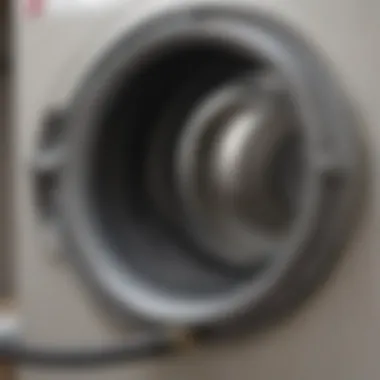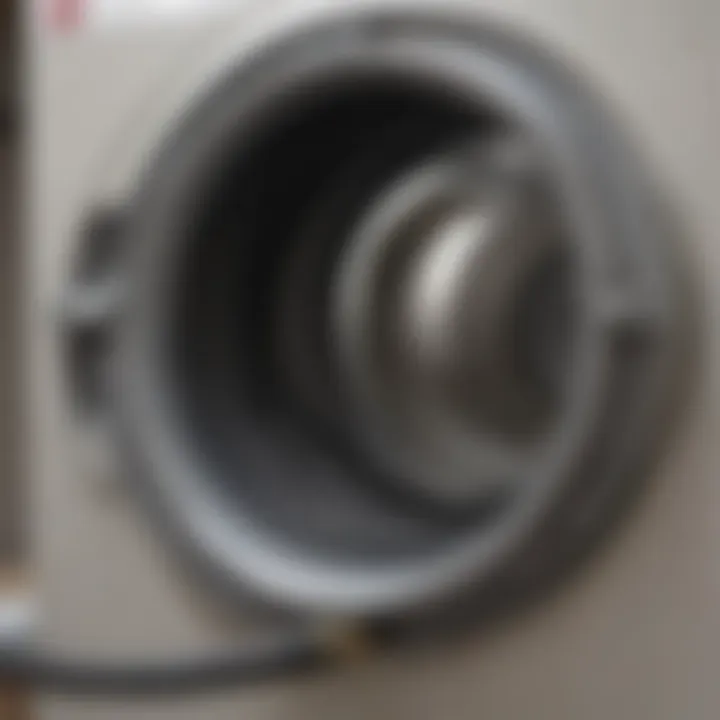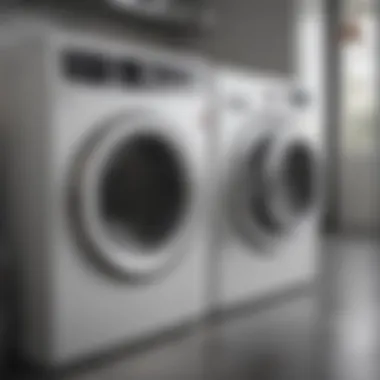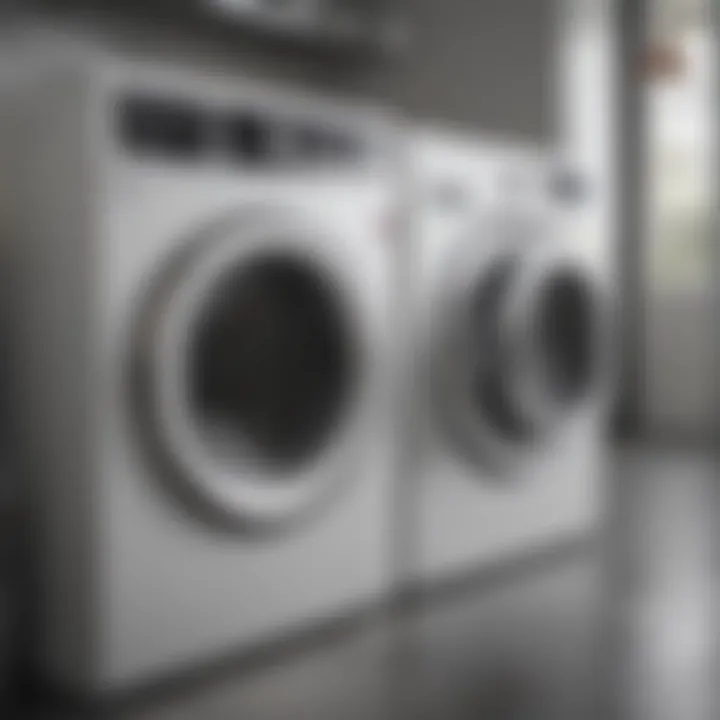Comprehensive Guide to Cleaning Your Dryer for Safety


Intro
Maintaining a dryer is crucial for ensuring a safe and efficient laundry experience. Many homeowners overlook this task, yet regular cleaning can prevent potential fire hazards and improve the appliance's performance. By understanding the steps necessary for cleaning various components of your dryer, you can significantly contribute to its longevity and functionality.
Feature Spotlight
Lint Trap Cleaning
The lint trap is a primary component of any dryer. It captures loose fibers that can accumulate during a drying cycle. Over time, these fibers build up, blocking airflow. This can lead to overheating and, ultimately, a fire risk. Cleaning the lint trap requires minimal effort and can be done before each use:
- Remove the lint trap from its housing.
- Use your fingers or a soft brush to remove the lint.
- Rinse the trap with warm water to remove residue.
- Allow it to dry completely before reinserting.
Vent Hose Inspection
Another critical aspect of dryer maintenance is inspecting and cleaning the vent hose. A clogged vent can result in poor performance and overheating. Steps for inspection include:
- Disconnect the dryer from the power source.
- Disconnect the vent hose from the dryer and wall.
- Inspect for lint build-up or obstructions.
- Clean using a vacuum or a specialized brush.
- Reattach securely and ensure it is free of kinks.
Regular inspection and cleaning of the vent hose can enhance efficiency and minimize fire risks.
Drum Cleaning
The drum of your dryer requires attention as well. Dust and residues can accumulate over time, affecting cleanliness:
- Wipe the drum with a damp cloth.
- Use a mild detergent if needed.
- Run a drying cycle with a clean, dry towel to absorb moisture.
Importance of Maintenance
Neglecting dryer maintenance can lead to serious consequences, including:
- Increased energy consumption
- Risk of fire hazards
- Reduced lifespan of the appliance
By investing time in cleaning your dryer, you not only enhance its performance but also ensure a safer environment for your home.
As this guide unfolds, more insights will be provided on specific cleaning methods and their execution. The focus will remain on practicality, making it easier for homeowners to incorporate these tasks into their routine.
Understanding the Importance of Dryer Cleaning
Keeping your dryer clean is not just an aesthetic concern. It is an essential aspect of maintaining safety and ensuring that the appliance operates at peak efficiency. Negligence in cleaning can lead to serious safety hazards, including fires. According to the National Fire Protection Association, failure to clean dryer vents is a leading cause of home fires.
Dryers accumulate lint, dust, and debris over time. This buildup can obstruct airflow, reducing the device’s efficiency and increasing energy consumption. When the dryer works harder, it can wear out more quickly, leading to costly repair or replacement. Regular maintenance can increase a dryer’s lifespan and lead to significant energy savings.
Additionally, the performance of your dryer can impact the quality of your laundry. Clean dryers operate more effectively, drying clothes faster and more evenly. Dirty parts, like lint traps, can leave clothes damp or musty, potentially causing frustration.
"Routine cleaning is not merely a chore; it is a proactive step to safeguard our homes and optimize energy usage."
In summary, understanding the necessity of dryer cleaning goes beyond cleanliness. It encompasses safety, efficiency, and upkeep. Being informed about how to clean and maintain your dryer can lead to a more reliable and effective appliance.
Safety Implications
The risks associated with a dirty dryer are significant. One of the primary concerns is fire safety. Lint, which accumulates in the dryer and vent, is highly flammable. If a lint buildup is not addressed, the excess heat generated during operation can ignite the lint, causing a dangerous fire hazard.
Moreover, neglecting to clean the dryer may cause mechanical failures. When components are obstructed, there can be overheating, potentially damaging internal components. This scenario not only increases repair costs but also puts users at risk.
Efficiency and Performance
A dryer that is clean operates at optimal efficiency. When ducts and lint traps are clean, air can circulate freely, allowing the dryer to function effectively. Consequently, clothes dry faster, significantly reducing energy consumption. A lower electricity bill is often a welcome benefit of a well-maintained dryer.
In contrast, a clogged dryer leads to extended drying times, which can be frustrating. The appliance may need to cycle longer to dry the same load, leading to potential overheating and further wear on components. Maintaining cleanliness offers multiple advantages, including time efficiency and cost savings, all while ensuring the appliance fulfills its intended purpose effectively.
Essential Tools and Materials for Dryer Cleaning
Cleaning your dryer effectively requires specific tools and materials. The right preparation enables the process to be more efficient and thorough. Having the necessary items on hand ensures you can address all areas needing attention. It also minimizes the risk of missing crucial steps, which may compromise the cleanliness and safety of the appliance. Understanding these tools and materials is essential for maintaining an optimally functioning dryer.


Basic Tools Required
To start with, there are a few basic tools you should gather before beginning the cleaning process. These tools will aid you in accessing different parts of the dryer and executing the cleaning methods properly:
- Screwdriver: A standard screwdriver is vital for loosening screws found on the back panel and vent connections. It helps in gaining access to areas that might accumulate lint and debris.
- Vacuum Cleaner: A vacuum with a hose attachment allows you to remove lint from tight spaces. This is essential in preventing blockages in the venting system.
- Lint Brush: Using a lint brush helps in effectively removing accumulated lint from the lint trap and other surfaces. This is a simple yet effective tool that can significantly improve dryer performance.
- Small Brush or Cleaning Cloth: A soft-bristled brush or a microfiber cloth is useful for wiping surfaces. These tools handle delicate components without causing damage or scratches.
Having these basic tools ready will facilitate a smoother cleaning experience.
Recommended Cleaning Supplies
In addition to tools, certain cleaning supplies enhance the effectiveness of the cleaning routine significantly. These recommended supplies will help ensure your dryer is not just cleaned but also maintained properly:
- Dish Soap: A gentle dish soap diluted in water can be used to clean the lint trap. It effectively breaks down residues that may accumulate over time.
- Vinegar: Vinegar is useful for deodorizing and eliminating odors within the drum. Its natural cleaning properties make it an effective cleaning agent.
- Baking Soda: For deep cleaning, a mixture of baking soda and vinegar can help cut grease and grime. It is a safe way to maintain the drum and other internal parts.
- All-Purpose Cleaner: An all-purpose cleaner can be effective for surfaces outside the drum. This will ensure your dryer appears clean and well-maintained.
Understanding how to incorporate these tools and cleaning supplies into your routine significantly enhances the effectiveness of your dryer cleaning efforts. By being adequately equipped, you can maintain the appliance in a manner that ensures safety and efficiency.
Preparing Your Dryer for Cleaning
Preparing your dryer for cleaning is a critical step that ensures safety and effectiveness in the cleaning process. When a dryer is not properly prepped, it can lead to neglecting essential areas that require attention, potentially resulting in decreased efficiency or, in worst-case scenarios, fire hazards. Taking time to address the readiness of your dryer can enhance the entire cleaning experience and improve long-term performance.
Unplugging the Unit
The first action to take when preparing your dryer is to unplug the unit. This is crucial not only for safety reasons, but also to avoid any accidental starts while performing maintenance. Highly energized electrical parts can pose serious risks. Given the appliance’s nature and the heat involved during operation, ensuring that the dryer is disconnected from power eliminates any potential hazards. Always ensure that you are physically disconnecting it from the wall outlet before proceeding to any further cleaning tasks.
Clearing the Surrounding Area
Before diving into the actual cleaning, it is necessary to clear the surrounding area around the dryer. This means moving any laundry baskets, clutter, or obstacles that could hinder access or create safety hazards. A clean workspace is essential, as it increases efficiency and reduces the risk of accidental injuries. Consider also that accumulated dust and lint in the vicinity could escape during cleaning and create additional mess elsewhere. Having a designated space for equipment and materials will help streamline the process. Ensure adequate lighting, as well, to spot any overlooked issues more clearly.
"Taking the time to prepare for cleaning not only protects you but sets the stage for a more effective cleaning session."
Following these two crucial steps in the preparation phase makes the cleaning process less cumbersome and more efficient. It allows you to focus on specific tasks that enhance the dryer’s performance without worrying about possible safety issues. Proper preparation cannot be overstated, as it paves the way toward thorough and safe maintenance.
Cleaning the Lint Trap
Cleaning the lint trap is a pivotal aspect of dryer maintenance. A clean lint trap not only ensures that your dryer functions at optimal efficiency but also directly relates to safety in the home. Lint buildup can lead to overheating, which poses a fire risk. The process is fairly straightforward, yet countless users neglect this essential step. Understanding how to effectively manage this aspect can significantly enhance the longevity of the appliance.
Removal Process
To begin, ensure the dryer is turned off and unplugged to prevent any accidents. The lint trap is typically located either on top of the dryer or inside the door. To remove the lint filter, gently pull it out. It’s important to handle it carefully to avoid damage. Inspect it for any visible lint buildup. If it appears caked with fabric fibers, proceed cautiously to the next step in your cleaning routine.
Washing the Lint Filter
Once the lint filter is removed, it requires proper washing to ensure complete cleanliness. Use a soft brush and hot, soapy water. A nylon brush can help dislodge stubborn lint attached to the mesh material. Rinse thoroughly under warm water to remove any soap residue and lint particles. It’s essential to dry the filter completely before reinserting it back into the dryer. This step helps maintain airflow.
To maintain the filter's effectiveness, regularly check and clean your lint trap after every load of laundry. Establishing this habit minimizes risks associated with dryer fires, efficiently reduces drying times, and prolongs the operational health of your dryer.
Inspecting and Cleaning the Vent Hose
Inspecting and cleaning the vent hose is a critical step in maintaining dryer efficiency and safety. Neglecting this aspect can lead to serious consequences such as reduced performance, increased energy bills, and even fire hazards. The vent hose carries moist air, lint, and heat safely outside your home. If it becomes blocked or dirty, it can cause your dryer to work harder than necessary. This not only affects drying times but can also overheat the machine, posing potential risks including fire.
Disconnecting the Vent Hose
To effectively clean the vent hose, start by disconnecting it from the back of the dryer. First, ensure the dryer is unplugged to prevent any electrical accidents. Once unplugged, you may need a screwdriver to detach any screws that secure the vent hose. Carefully pull the hose away from the dryer. Note that some hoses are flexible and can be twisted off. Handle with care as some connectors might be fragile, especially if the dryer is older. If you notice any cracks or holes during this process, consider replacing the vent hose.
Checking for Blockages
Once the vent hose is disconnected, inspect it for blockages. Shine a flashlight inside to look for lint buildup or other obstructions. A thorough inspection will reveal any major blockages, which can impede airflow. Also, check the vent duct leading to the exterior of your home. Blockages can often form at bends in the duct or at the outside vent where lint tends to accumulate. If you find significant blockage, it’s important to remove it to ensure optimal airflow.
Cleaning Techniques
To clean the vent hose, there are several effective methods you can use:
- Lint Brush: A specialized lint brush can help remove build-up inside the hose.
- Vacuum: A vacuum with a narrow attachment allows you to suck out lint and debris effectively.
- Rod Cleaning Kit: A rod cleaning kit can reach deep into long sections of vent hose, breaking up and pulling out clogs.


It is recommended to clean the vent hose at least once a year as part of a regular maintenance schedule. Regular cleaning will not only maintain efficiency but also prolong the appliance's lifespan. After cleaning, reattach the vent hose securely and plug your dryer back in to avoid any issues.
Drum Cleaning
Drum cleaning is a crucial aspect of maintaining your dryer. The dryer drum is the central component where your clothes are placed for drying. Keeping it clean is essential for several reasons. First, a dirty drum can leave residues on your clothing, causing them to smell unpleasant or appear dingy. Second, any leftover lint or debris can impact the dryer’s efficiency. Regular drum cleaning not only addresses these issues, but it can also prolong the life of your appliance.
Wiping Down the Interior
Wiping down the interior of the dryer drum is a straightforward yet highly effective cleaning method. Start by gathering your materials, including a soft cloth and a gentle cleaning solution. Prepare a mixture of warm water and a mild detergent. Dampen the cloth with the solution, ensuring it’s not soaking wet, as excess moisture could damage the dryer components.
To clean the drum, open the dryer door and carefully wipe the interior surfaces. Pay special attention to any visible stains or spots, making sure to clean them thoroughly. This step not only enhances hygiene but also improves the overall performance of the dryer. After wiping, it is vital to dry the interior with a clean, dry cloth to remove any moisture left behind. Regularly wiping down the interior can keep your dryer functioning optimally.
Deodorizing the Drum
Deodorizing the drum is another essential cleaning task that should not be overlooked. Over time, odors can accumulate inside the dryer drum from damp clothing and laundry products. To eliminate these smells, consider using a simple method. Mix equal parts of white vinegar and water in a spray bottle. Spritz the interior lightly with this solution, ensuring that you cover the entire drum surface.
After applying the deodorizing spray, allow it to sit for about 15 minutes. This allows the solution to penetrate and neutralize any odors effectively. Once the time has elapsed, wipe the drum with a clean cloth. The result will be a fresh-smelling, clean dryer drum that enhances the overall laundry experience. Incorporating deodorizing into your cleaning routine can significantly improve air quality inside the dryer and ensure your clothes come out smelling fresh.
Regular cleaning of the dryer drum enhances its efficiency and prolongs its lifespan.
In summary, drum cleaning, especially wiping down the interior and deodorizing, is vital for optimal dryer performance. By giving proper attention to these processes, you safeguard your appliance and improve the quality of your laundry.
Checking Electrical Components
Proper maintenance of your dryer extends beyond physical cleaning. It also involves checking its electrical components. This aspect is crucial for ensuring the safety and efficiency of your appliance. Over time, wiring can wear down or become damaged, which poses not only a risk of malfunction but also potential fire hazards. By examining these components, you can prevent costly repairs and enhance the longevity of your dryer.
Examining Wiring for Damage
When checking the wiring of your dryer, start by inspecting hoses and cords for any visible signs of fraying or cuts. Look closely at the connections between wires and terminals. Detecting issues early can save you from serious problems later. A damaged wire can cause short circuits, which may lead to fires. If you find damaged wiring, it is essential to replace it before using the dryer again.
- Safety first: Always ensure the dryer is unplugged before beginning any inspections.
- Look for discoloration or melted areas, as these can indicate overheating.
- Use a multimeter to test continuity in wires, ensuring that they conduct electricity properly.
Assessing the Power Source
The power source of your dryer is also a critical aspect to examine. A dryer typically runs on a dedicated circuit that requires a certain voltage to operate effectively. If there are fluctuations in this power supply, it can lead to inefficient performance or damage to your machine.
To assess the power supply:
- Check the circuit breaker for any tripped switches, which may indicate an overload or short.
- Ensure the outlet is functioning correctly; using a voltage tester can help identify issues.
- If you experience frequent issues or power outages, it may be worth consulting a qualified electrician to evaluate the electrical setup.
Regular checks of electrical components not only enhance dryer performance but also significantly reduce safety risks.
By incorporating these inspections into your regular maintenance routine, you will ensure your dryer remains safe and functional for years to come.
Avoiding Common Cleaning Mistakes
Cleaning your dryer effectively involves several steps, but equally important is knowing what not to do. Avoiding common cleaning mistakes ensures both safety and efficiency. Neglecting certain areas or using the wrong products can compromise the performance of the dryer and increase the risk of hazards. By being aware of these mistakes, you can maintain a properly functioning appliance.
Using Improper Cleaning Agents
The choice of cleaning agents can greatly impact the outcome of your dryer cleaning efforts. Using improper cleaning agents, such as harsh chemicals or abrasive materials, may not only lead to damage on internal surfaces but also leave harmful residues. For instance, cleaning sprays meant for kitchens or bathrooms should never be directed towards dryer components. These agents can produce fumes that are dangerous if inhaled.
Instead, focus on mild detergents specifically designed for the materials involved. Options like vinegar or baking soda are often more effective and safer for cleaning lint traps and the interior drum.
To summarize, avoid:
- Harsh chemicals that may damage internal components.
- Abrasive materials that can scratch surfaces.
- Leftover residues that can interfere with dryer function.
Neglecting the Back of the Dryer
Another frequent error is neglecting to clean the back of the dryer. Many homeowners assume that if the visible parts look clean, then they are fine. However, the back area often accumulates lint, dust, and other debris over time. This neglect can impede air circulation and increase the risk of overheating.
To properly clean the back of your dryer, ensure that you:


- Unplug the dryer to prevent electrical hazards.
- Move the dryer away from the wall to access the rear.
- Use a vacuum cleaner to remove any buildup of lint and dust. This process helps maintain proper airflow and reduces the risk of fire hazards.
Always remember, cleaning is not merely about what one can see; oftentimes, hidden spots require just as much attention for optimal performance.
Reassembling and Testing the Dryer
Reassembling and testing the dryer is a critical step following the cleaning process. Ensuring that each component is correctly put back in place is essential for the dryer to function effectively and safely. Any oversight can lead to operational failures, decreased efficiency, or even safety risks, making this stage not only important but also meticulous.
Reattaching the Vent Hose
One of the primary tasks in the reassembly process is reattaching the vent hose. This hose is integral to the dryer as it carries the moisture-laden air outside the home. A proper attachment is crucial for several reasons:
- Preventing Lint Buildup: A securely fastened vent hose minimizes the chance of lint accumulation, which is a major fire hazard. Any gaps may allow lint to escape into the area around the dryer, posing risks.
- Optimizing Airflow: If the vent hose is not connected properly, airflow can be impaired, which directly affects the efficiency of the dryer. Proper airflow helps in drying clothes thoroughly without wasting energy.
- Ensuring Safety: Leaks in the vent can lead to heat buildup and increased fire risk. Ensuring that the hose is tightly reattached mitigates this concern.
When reattaching the vent hose:
- Start by inspecting the connections for any damage or wear.
- Align the hose appropriately to avoid kinks.
- Use clamps to secure it if necessary, ensuring a tight seal.
Plugging the Unit Back In
After checking and reattaching the vent hose, the next significant action is plugging the dryer back into the power source. This step, while simple, comes with its own set of considerations:
- Confirming Safety: Before plugging in, double-check that the area is dry and free of debris. An electrical short due to moisture can lead to serious hazards.
- Verifying Connections: Ensure that the power cord and outlet are in good condition. Old or damaged cords can pose risks of electric fires.
- Testing Functionality: Once plugged in, run a short cycle to test if the dryer operates correctly. Listen for any unusual sounds and observe the air vent to ensure that air is flowing as expected.
A successful reassembly means your dryer will operate safely and efficiently. Ensuring that each step is followed can significantly reduce risks associated with dryer usage.
After completing both steps, you should document any issues encountered during cleaning or reassembly. This information is useful for future maintenance, informing you if problems persist after reassembly and testing. Ultimately, these processes not only enhance performance but also contribute to a safer home environment.
Establishing a Cleaning Schedule
Establishing a regular cleaning schedule for your dryer is crucial for maintaining efficiency and safety. Without periodic maintenance, the dryer can accumulate lint and debris, which may not only hinder its performance but also pose a fire hazard. An organized schedule helps in developing a routine that keeps your appliance running smoothly. A consistent approach to cleaning enhances longevity and minimizes unexpected breakdowns, ensuring that the unit operates effectively.
Frequency Recommendations
When it comes to cleaning your dryer, the frequency of maintenance depends on several factors, including usage level and type of laundry. Light users, who dry fewer loads weekly, might focus on maintenance every few months. In contrast, heavy users may require bi-monthly cleanings to avoid lint buildup. Here are some general frequency guidelines:
- Light use: Every 3-4 months
- Moderate use: Every 2 months
- Heavy use: Monthly
Regular checks ensure that lint does not become a fire risk. Opting for a systematic approach will help you keep track of what cleaning steps are performed and when they were last done.
Monthly Checks vs. Deep Cleanings
Deciding between conducting monthly checks versus deep cleanings is another essential aspect to consider. Monthly checks are quick maintainence tasks that involve inspecting the lint trap, checking the exhaust vents for blockages, and wiping down the drums. These checks should focus on maintaining functionality and preventing minor issues.
Deep cleaning, on the other hand, requires more comprehensive actions such as:
- Disconnecting and cleaning the vent hose:
- Cleaning the drum thoroughly:
- Prevent lint from building up in hard-to-reach areas.
- Remove accumulated residue and odors.
Monthly checks ensure immediate issues are addressed promptly, while deep cleanings can be scheduled quarterly or bi-annually to ensure a thorough cleanse of all components. Combining both approaches will provide optimal performance and safety for your dryer.
"An organized cleaning schedule not only helps your dryer run efficiently, but also protects your home from potential fire hazards."
Utilizing a practical approach to maintaining your dryer will lead to a more efficient operation and prolonged lifespan of the appliance.
Epilogue
Summary of Key Points
- Safety should be a top priority when it comes to dryer maintenance, as neglecting cleaning can lead to dangerous situations.
- A clean lint trap increases drying efficiency, which ultimately saves time and reduces energy usage.
- Inspecting the vent hose is vital. Blockages can cause overheating and potentially damage your dryer.
- Establishing a cleaning schedule can help keep your dryer in pristine condition and prevent emergencies from occurring.
- Regular checks can identify wear and tear in electrical components, ensuring safe operation.
Final Thoughts on Dryer Maintenance
Dryer maintenance is often overlooked yet is essential. By following the steps outlined throughout this guide, homeowners can prevent many issues associated with dirty appliances. Keeping your dryer clean may seem tedious, but it is a small effort that yields significant benefits.
Remember, investing time in your dryer’s maintenance not only enhances its functionality but also safeguards your home. To make this task more manageable, consider setting monthly reminders to check and clean parts of the dryer. A consistent, proactive approach ensures your dryer remains reliable for years to come.
"An ounce of prevention is worth a pound of cure."







